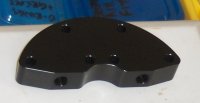 |
This
is the kidney I started with. It is a blank kidney without any of the
normal connections for the KISS displays or any of the millwork to the top
surface of a standard kidney. Two holes have been drilled on the front
face of it and these have been tapped for a M12x1.5 thread. |
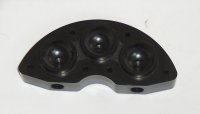 |
This
is the underside. It looks fairly standard but what is hard to make out in
the picture is that there are a couple of channels drilled between the
left and right cell domes into the centre dome. |
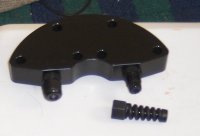 |
Next
fit the cable gland. I have used IP68 environmentally sealed glands from
Rapid Electronics. These glands are also rated to 5bar of pressure on top
of the IP68 designation (Rapid do glands with a higher pressure rating but
they start at M16 thread and as the kidney is at ambient pressure then the
5bar rating should be adequate). The strain relief collar should be fitted
to the Shearwater cable now.
The other gland is there only to blank
off the spare hole. It has been packed out and blocked with sealant. What
I didn't think of at this stage was that the ADV swivel would sit right in
front of it so it had to be cut down later. |
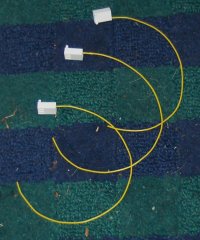 |
Prepare some molex connectors with the ground leads
fitted. If you look at the top of the connector with the guides pointed up
(so it looks like a U) then the ground lead is on the left with R22D
cells. I've done three but I actually only needed two. |
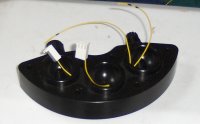 |
Fit
one in the cell dome furthest from the cable gland and pass the wire
through the channel and into the centre dome. Pass that again into the
next channel into the cell dome closest to the gland. Insert another molex
into the middle dome, pass the cable through the channel and into dome
next to the gland. If you have used the same colour wire as I have then
mark which is which. |
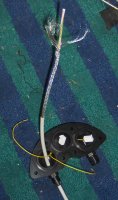 |
Fit
the Shearwater cable through the gland and decide what length you want
it. Cut the outer sheath away then strip away the inner braided wire
sheath and finally the inner plastic film
sheath. |
 |
Seperate out the wires. This is now the hard part,
you need to identify which wire should connect to which cell. If you are
monitoring three cells then the Shearwater reads one wire from each of the
cells and a common ground lead, so the computer uses four wires. If you
are using a Shearwater cable from Tecme then it has seven cores so
obviously three of these are useless, one is the ground lead and three are
the cell leads. On the Shearwater website it describes the pin layout for
the Fischer connector to the computer, however it is pretty useless as
there are seven pins on the Fischer connector and there is no diagram of
which is which.
You now need to identify which lead is which. On
mine, the ground was blue and the cell wires were green, white and brown.
This may or may not be the same as yours. How I did it:
- take a
cell and fit a molex with two leads coming out with stripped ends
-
switch on the Shearwater and put it into external cell monitoring mode. It
will read 0.00 on all three cells
- connect the cell leads to any two
of the cable cores
- switch the computer to millivolt mode
- look
for a reading on one cell
- if you get a reading then note which cores
they were
- work your way through the other five cores
With a
bit of trial and error you can work out which is the ground lead and which
are the cell leads. |
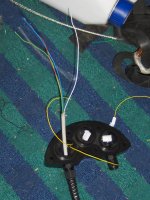 |
If
you haven't lost the will to live by this point then it's probably a good
time for a beer. Now that you have ID'd which are the good cores and which
are dead, cut back the dead ones. |
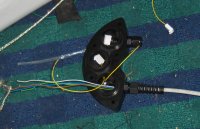 |
Pull the cable out until the outer sheath is just
inside the dome. Tighten the strain relief down on to the gland to secure
the cable. If your gland has a torque setting on the data sheet then use
it because some are very easily broken. |
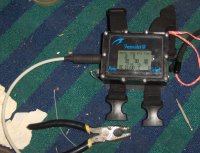 |
Hook the Fischer cable up to the Shearwater, switch
it on and make sure it is in external cell monitoring mode. |
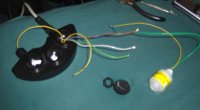 |
If
you haven't already done so then you need to ID which lead corresponds
with which cell on the display. It doesn't really matter but it does make
a bit of logical sense if the cells are in the same sequence on the
Shearwater display as they are on the KISS head. Fit a molex with two
leads on to a cell, hook the cell's ground to the Shearwater ground and
the other to one of the cell leads. |
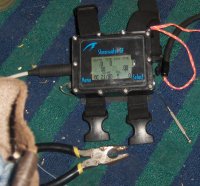 |
Check the Shearwater and note which position it
lights up on the display. Depending on whether or not the Shearwater has
previously had a good calibration then you may not get a reading, if this
is the case then switch to millivolt mode. |
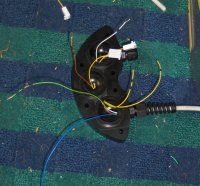 |
When you have ID'd which
wire is which then mark it and insert it into the correct
dome. |
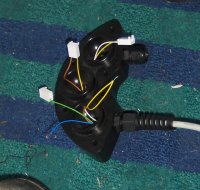 |
Crimp a pin on to the cell lead nearest the gland. On
the other two, crimp pins on to the ends of the cell leads and fit them
into the molexes which have been previously fitted to the ground
leads.
Splice the two ground leads
together. |
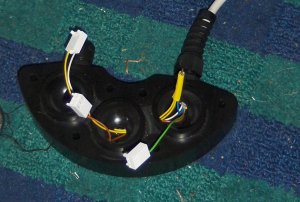 |
Splice in the ground lead from the Shearwater cable into the other grounds. If
you can get away with it then crimp a pin on the end and fit the
bundle of wires into the last molex. I couldn't get a secure connection this way so
I ended up splicing a short lead on to the ground wire
bundle, putting a load of solder on the joint and then a lump
of heatshrink on top with a blob of aquasure. I crimped a pin on to the
other end of the lead and fixed that into the molex. |
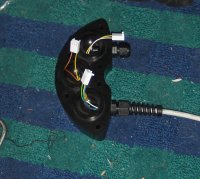 |
And
there is the end result. You should have three molex connectors in three
domes. |
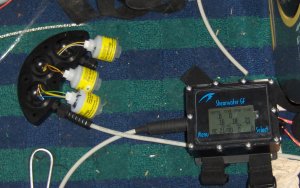 |
Hook up the three cells
and switch on the Shearwater. You should get a reading on all three cells.
It doesn't really matter what the readings are at this stage as long as
they are there. If the Shearwater hasn't been calibrated then
there may not be any reading. Either way, switch it to millivolt mode
and check the values. You should be getting in the region
of 10.5mV on each cell. Blow some O2 onto each cell, the mV
should get up to 49-50. |
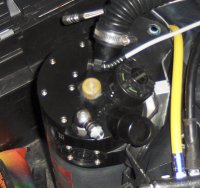 |
Fit
the cells into the head. Fit the o-rings on to the turrets of the kidney
then fit the kidney on to the head. With the rebreather fully assembled do
a positive check and watch for leaks round the gland.
With the
Shearwater switched on, flush the loop with oxygen and do a calibration on
the Shearwater. Disconnect the exhale hose and breathe from the DSV, forcing fresh air into the loop. Check that the Shearwater
display drops back to the 0.21 (or thereabouts). |

















